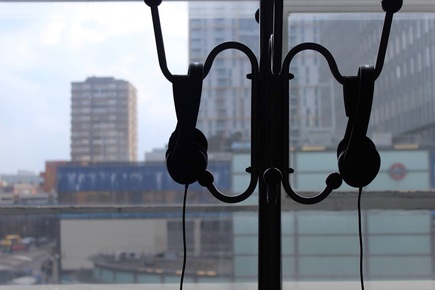
"Urban spaces, narratives, and subjectivities are thus comprehended as the outcomes of cities and bodies mutually shaping each other" (Collie, 2013).
Narrating the Urban Space (2017), consisting of seven listening stations, occupies a realm where visual elements and sonic layers converge. It delves into the relationship between the interior and exterior of architectural space, emphasizing human interaction. The installation prompts an engagement with both external occurrences and internally projected sounds, highlighting divisions between public and private spaces by intertwining inner and outer sounds.
"Bodies project themselves onto their sociocultural environment so that this environment both produces and reflects the form and interests of the body. Introjections and projections involve a complex feedback relation in which neither the body nor its environment can be assumed to form an organically unified ecosystem" (Grosz, 1995, p.242).
Traversing themes of personal narratives, memories, time, and motion, this site-specific sound installation invites participants to position themselves within the surroundings of CRiSAP and London College of Communication. Narrating the Urban Space projects documented sounds from New York City's Grand Central Station, weaving personal and physical space through the area, creating an intimate experience.
Situated overlooking Elephant and Castle's Underground Station, the installation raises questions about sound ownership and belonging. As listeners engage, the outside view merges with sounds from headphones, forming a cohesive illusion. Underground sounds, traffic signals, and fragmented conversations mirror external views, creating a cinematic atmosphere, with the place becoming an extended instrument.
“Stories about place produce a second, metaphorical geography of the city, insinuating other routes through which everyday urban practices are organised and given meaning. Stories, as enunciations, create space via an “enunciative focalisation” that inserts the speaking body into the text”. (Collie, 2013)
The crossing of boundaries between cities and identities becomes discernible only upon removing the headphones. As a commuting space, the environment constantly changes, but the sounds persist. This site-specific installation, referencing a specific place in an abstract form, explores the relationship between cities and bodies, aiming to suggest embodiment and a sense of belonging. The spectator's interaction completes the work.
With a sculptural assemblage at its core, this installation serves as a centrepiece in the room, providing a stable and present position that allows for spacious auditory experiences. Connecting bodies merge within the experience, accessible for multiple interactions simultaneously, resulting in a public organisation with restricted viewing.
Addressing the public, as seen in Max Neuhaus' New York-based installation 'Drive in Music 1967,' involves producing objects and events in conversation with bodies and spaces, undoing the art object for a more integrated and live experience. Neuhaus invites an audience or listener to claim the work for themselves, "where the shifting location is suddenly enhanced to become one's very own musical performance" (Neuhaus, 1967).
Narrating the Urban Space (2017), consisting of seven listening stations, occupies a realm where visual elements and sonic layers converge. It delves into the relationship between the interior and exterior of architectural space, emphasizing human interaction. The installation prompts an engagement with both external occurrences and internally projected sounds, highlighting divisions between public and private spaces by intertwining inner and outer sounds.
"Bodies project themselves onto their sociocultural environment so that this environment both produces and reflects the form and interests of the body. Introjections and projections involve a complex feedback relation in which neither the body nor its environment can be assumed to form an organically unified ecosystem" (Grosz, 1995, p.242).
Traversing themes of personal narratives, memories, time, and motion, this site-specific sound installation invites participants to position themselves within the surroundings of CRiSAP and London College of Communication. Narrating the Urban Space projects documented sounds from New York City's Grand Central Station, weaving personal and physical space through the area, creating an intimate experience.
Situated overlooking Elephant and Castle's Underground Station, the installation raises questions about sound ownership and belonging. As listeners engage, the outside view merges with sounds from headphones, forming a cohesive illusion. Underground sounds, traffic signals, and fragmented conversations mirror external views, creating a cinematic atmosphere, with the place becoming an extended instrument.
“Stories about place produce a second, metaphorical geography of the city, insinuating other routes through which everyday urban practices are organised and given meaning. Stories, as enunciations, create space via an “enunciative focalisation” that inserts the speaking body into the text”. (Collie, 2013)
The crossing of boundaries between cities and identities becomes discernible only upon removing the headphones. As a commuting space, the environment constantly changes, but the sounds persist. This site-specific installation, referencing a specific place in an abstract form, explores the relationship between cities and bodies, aiming to suggest embodiment and a sense of belonging. The spectator's interaction completes the work.
With a sculptural assemblage at its core, this installation serves as a centrepiece in the room, providing a stable and present position that allows for spacious auditory experiences. Connecting bodies merge within the experience, accessible for multiple interactions simultaneously, resulting in a public organisation with restricted viewing.
Addressing the public, as seen in Max Neuhaus' New York-based installation 'Drive in Music 1967,' involves producing objects and events in conversation with bodies and spaces, undoing the art object for a more integrated and live experience. Neuhaus invites an audience or listener to claim the work for themselves, "where the shifting location is suddenly enhanced to become one's very own musical performance" (Neuhaus, 1967).